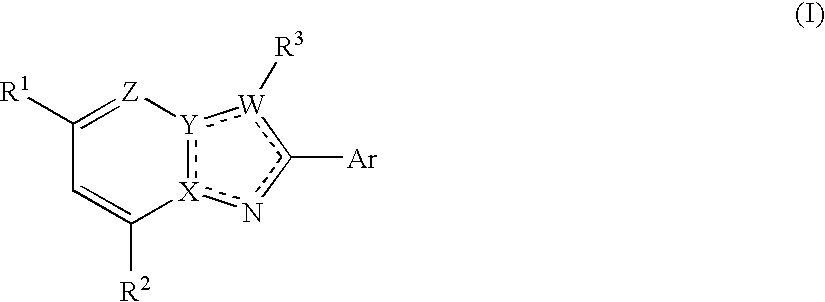Bicyclic heterocyclic compound
- Summary
- Abstract
- Description
- Claims
- Application Information
AI Technical Summary
Benefits of technology
Problems solved by technology
Method used
Image
Examples
example 1
1-(2-chloro-4-methoxyphenyl)propane-1-one
[0196]Propionic chloride (12.6 mL) was dropped to aluminum chloride (19.2 g) in carbon tetrachloride suspension (100 mL) under ice-cold, followed by stirring for 15 minutes. 3-chloroanisole (17.1 g) in carbon tetrachloride solution (30 mL) was dropped to the obtained mixture while the inner temperature was kept at 5° C. The mixture was stirred under ice-cold for 20 minutes. The reaction mixture was poured into the diluted hydrochloric acid / ice and extracted with ethyl acetate. The extract was washed with diluted hydrochloric acid, a saturated sodium hydrocarbon solution, and a saturated salt solution, and concentrated under reduced pressure after drying with anhydrous magnesium sulfate. The obtained residue was purified by silica gel column chromatography (hexane:ethyl acetate=20:1→10:1), to thereby obtain a title compound (12.1 g) having the following physical properties.
[0197]TLC: Rf 0.57 (hexane:ethyl acetate=4:1);
[0198]1H-NMR (300 MHz, CD...
example 2
2-bromo-1-(2-chloro-4-methoxyphenyl)propane-1-one
[0199]Tribromophenyl trimethylammonium (21.8 g) was added to the compound produced in Example 1 in tetrahydrofuran solution (THF; 120 mL) at room temperature, followed by stirring for 10 minutes. The insoluble substance was filtered with a glass filter and the filtrate was concentrated under reduced pressure. The obtained residue was purified by silica gel chromatography (hexane:ethyl acetate=10:1), to thereby obtain a title compound (17.9 g) having the following physical properties.
[0200]TLC: Rf 0.63 (benzene:hexane:ethyl acetate=4:4:1);
[0201]1H-NMR (300 MHz, CDCl3): δ 7.57 (d, J=8.4 Hz, 1H), 6.94 (d, J=2.7 Hz, 1H), 6.85 (dd, J=2.7, 8.4 Hz, 1H), 5.33 (q, J=6.6 Hz, 1H), 3.85 (s, 3H), 1.89 (d, J=6.6 Hz, 3H).
example 3
tert-butyl{5-[1-(1H-1,2,3-benzotriazol-1-yl)-1-ethylpropyl]-3-methylpyridin-2-yl}carbamate
[0202]Di-tert-butyl dicarbonate (11 g) was added to 5-[1-(1H-1,2,3-benzotriazol-1-yl)1-ethylpropyl]-3-methylpyridin-2-amine (compound described in J. Chem. Soc, Perkin Trans 1 1995 (24), 3129)(7.46 g) in ethyl acetate solution (100 mL), followed by refluxing by heat for 1.5 hours. The reaction mixture was concentrated under reduced pressure. The obtained residue was purified by silica gel column chromatography (hexane:ethyl acetate=2:1→1:1), to thereby obtain a title compound (6.2 g) having the following physical properties.
[0203]TLC: Rf 0.54 (hexane:ethyl acetate=1:2);
[0204]1H-NMR (300 MHz, CDCl3): δ 8.25 (d, J=2.1 Hz, 1H), 8.06 (dt, J=8.1, 0.9 Hz, 1H), 7.28 (m, 1H), 7.18 (m, 1H), 6.79 (m, 1H), 6.72 (s, 1H), 2.75 (m, 2H), 2.58 (m, 2H), 2.15 (s, 3H), 1.52 (s, 9H), 0.68 (t, J=7.2 Hz, 6H).
PUM
 Login to View More
Login to View More Abstract
Description
Claims
Application Information
 Login to View More
Login to View More - R&D
- Intellectual Property
- Life Sciences
- Materials
- Tech Scout
- Unparalleled Data Quality
- Higher Quality Content
- 60% Fewer Hallucinations
Browse by: Latest US Patents, China's latest patents, Technical Efficacy Thesaurus, Application Domain, Technology Topic, Popular Technical Reports.
© 2025 PatSnap. All rights reserved.Legal|Privacy policy|Modern Slavery Act Transparency Statement|Sitemap|About US| Contact US: help@patsnap.com



